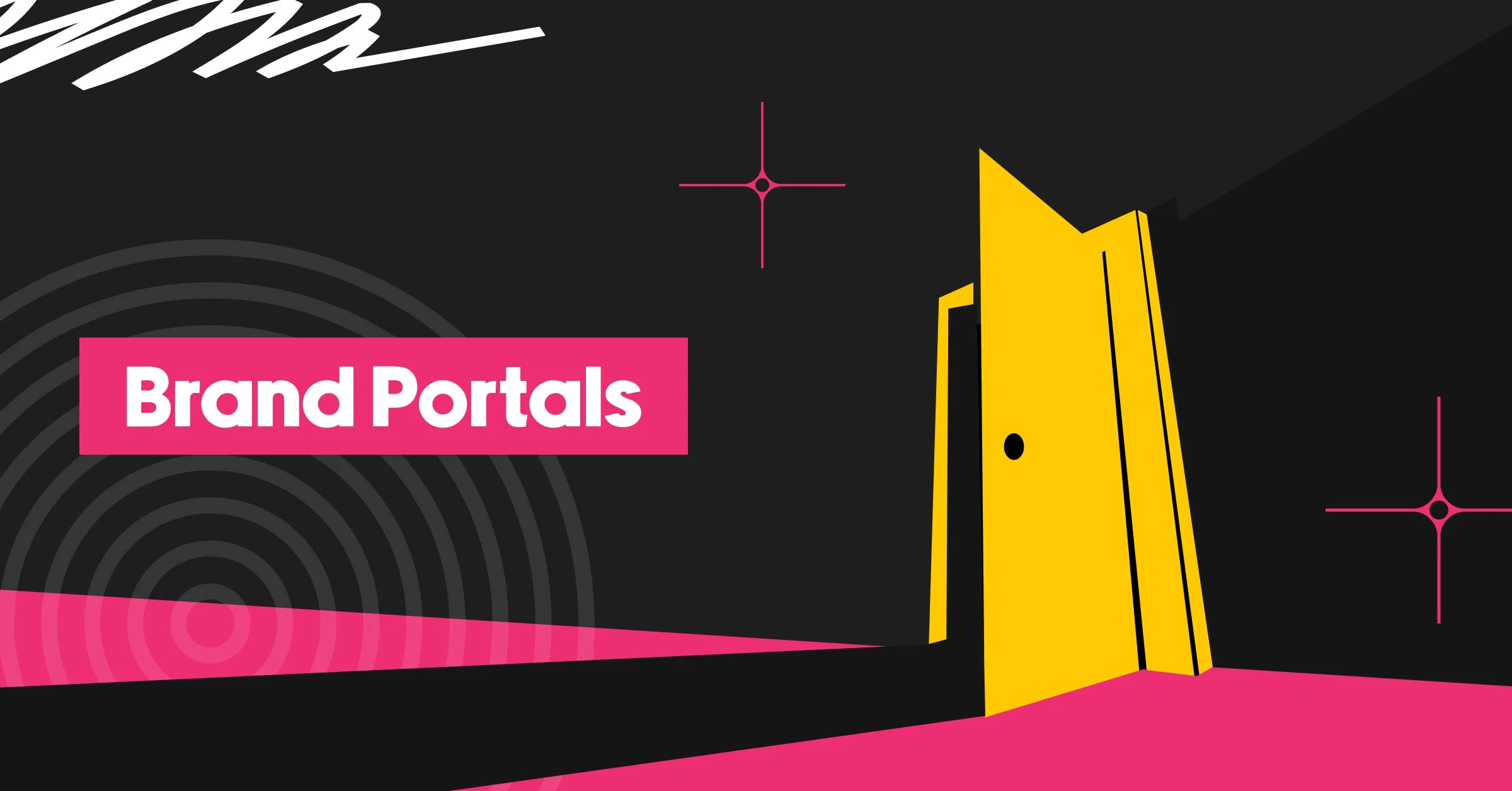Every time someone asks, “Where’s the latest logo?” a little part of your soul dies.
Not because you don’t care, but because you do.
You care about the brand, the craft, and getting it right. But instead, your days get eaten up by asset requests, rogue designs, and endless Slack threads debating which preso is “the right one.”
One team can’t find the right hero image. Another rebuilds a flyer from scratch. Designers are stuck fielding tickets instead of doing the high-impact creative work they were hired for.
So how do you scale branded content without burning out your team – or breaking the brand?
What Brand Enablement is – and How it Solves the Distributed Marketing Dilemma
Most midmarket and enterprise marketing teams find themselves stuck in the same cycle: Distributed teams need content fast — flyers, decks, signage, social graphics. But without access or brand guardrails, non-designers either wait on creative (creating frustrating bottlenecks)… or go rogue.
As demand for content grows, creative and brand leaders are presented with the following dilemma: Should they protect the brand by owning production, or release control to move fast enough to support the business?
Neither is sustainable. And in the middle of that tradeoff? A team buried in asset requests, last-minute approvals, and constant rework.
Brand enablement resolves this.
Brand enablement is the strategic process of equipping teams across your organization (yes, even non-designers!) with the content, guidelines, and tools they need to activate your brand effectively.
It’s the system that replaces static brand guidelines and scattered asset folders with something interactive: a toolkit that gives teams the freedom and flexibility to create on-brand materials for their own audiences while staying within brand guardrails.
The Marq + MediaValet integration turned our creative process into a one-stop shop. Our teams can create, store, and share brand-approved materials in one connected system–no more back-and-forth.
Malia Hostetler, Sr. Manager of Creative Services, PT Solutions
Why does Brand Enablement matter for Marketing?
So why does Brand Enablement matter for Marketing?
Because without it, your creative team will always be distracted by production noise, and your brand will remain at risk. With it, you unlock scale without sacrificing control.
Brand enablement (and systems like DAM that power it) helps your team:
- Eliminate the daily chaos of asset requests
- Empower non-designers to create brand-compliant content independently
- Reduce rework and approvals through locked templates
- Free up your creative team for strategic, high-impact campaigns
- Activate your brand consistently across every channel, market, and team
From Guidelines to Activation: The Shift to Brand Enablement
For years, brand management centered around static brand guidelines. Those PDFs, playbooks, and shared folders told teams what not to do. But today’s distributed marketing orgs don’t just need rules. They need enablement.
Brand enablement represents a shift from brand policing to brand activation. Instead of acting as the gatekeeper, the brand team becomes a true champion for the revenue-driving teams they serve. They equip every team to create their own on-brand content confidently and efficiently.
With brand-locked templates, built-in permissions, and integrated asset access, brand enablement strengthens governance while eliminating the slow handoffs and production backlogs that weigh teams down.
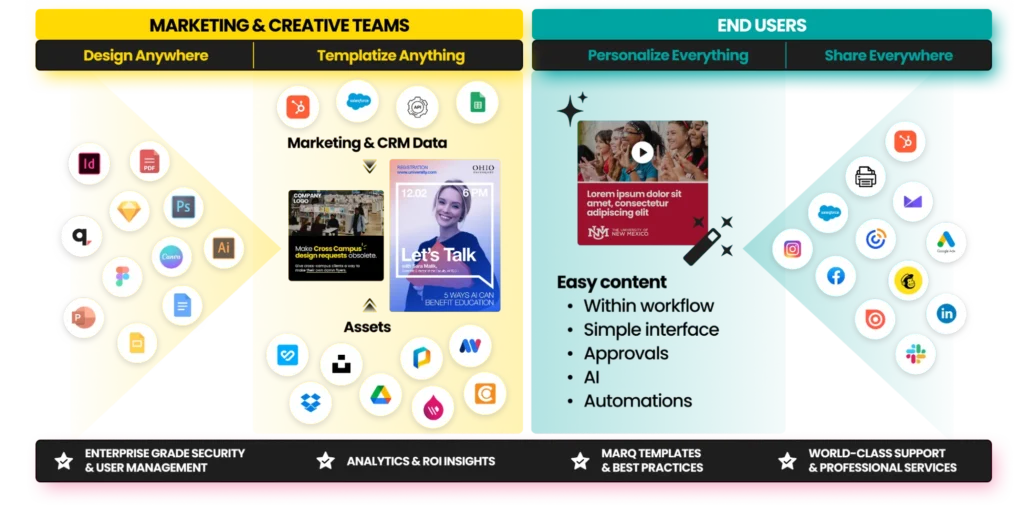
Brand enablement platforms, like Marq, bring centralized control and scalable content creation together in one system. Teams can expand into new regions, onboard newly acquired brands, support events, manage rebrands, or produce social content at speed, all without sacrificing brand integrity.
Of course, giving people access to the right assets (and knowing those assets are current, compliant, and brand-approved) doesn’t happen by accident. That’s where Digital Asset Management (DAM) comes in.
So how does a DAM support brand enablement and power this shift from static guidelines to scalable activation?
How Digital Asset Management (DAM) supports Brand Enablement
Modern brand enablement depends on more than just giving teams templates. It requires visibility, access, and control over the assets that feed those templates. This is where Digital Asset Management (DAM) becomes essential.
DAM platforms act as your brand’s central library: the place where your most important files — logos, images, video, product shots, campaign assets — are stored, tagged, and organized in one accessible location.
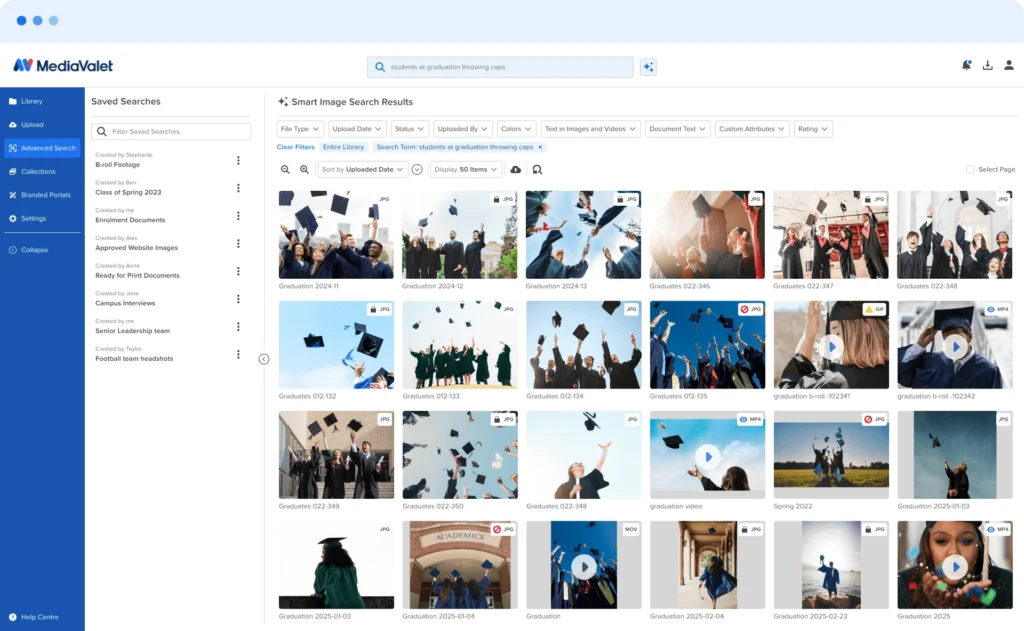
But a modern DAM does more than store content. The best DAMs streamline asset ingestion, connect the right users to the right assets in the right moment, and make sure those assets stay current, compliant, and on-brand.
When integrated into a brand enablement system, DAM transforms from a storage solution into a distribution engine. It allows teams to:
- Find and use approved assets fast, with AI tagging, search, and role-based permissions
Keep outdated or off-brand files out of circulation through version control and expiration policies - Power templated content by linking up-to-date assets directly into customizable templates
- Enable personalization at scale, while staying inside brand guidelines
This shift — from storing assets to activating them — allows teams to self-serve projects and scale content production without losing control of the brand.
The Strategic Value of DAM in a Brand Enablement Ecosystem
Integrating DAM with templating and brand management tools like Marq turns passive storage into brand activation.
Specifically, DAM supports brand enablement by reinforcing three critical pillars: brand consistency across teams, workflow efficiency through centralized access, and seamless cross-functional collaboration.
Consistency across channels and teams
When content lives in seven drives and five minds, every interaction risks going off-brand. Centralizing approved templates, images, videos, and documents in a DAM keeps every team — whether building a deck in Denver or launching a campaign in Tokyo — pulls from the same, approved source.
Productivity gains through centralized content control
A modern DAM goes beyond storage (think Box or Google Drive) and provides functionality to help teams find the assets they need, when they need them, without having to navigate folders or chase down approvals.
DAM smooths the way between “I need it” and “I found it” with Smart search and AI tagging features. These features let teams:
- Move and categorize assets from photographers and designers en masse, without wait times needed for manual image ingestion
- Surface the right versions in seconds
- Use granular permissions hide outdated, sensitive, or off-brand assets
Instead of hunting folders or resending old decks, teams jump straight into execution, confident the asset they grab is current, compliant, and ready to ship.
Enhanced collaboration across departments
DAM platforms also simplify how content gets shared across departments. With advanced sharing and tagging, teams can work from the same asset without duplicating effort. The best systems also offer branded portals for securely sharing content with external partners, regional teams, or vendors.
A DAM alone provides crucial governance, asset management, and centralized control. It does not directly empower users to create brand-consistent collateral at scale.
That’s where templating comes in. It transforms static assets into dynamic, customizable tools.
Best Practices for Implementing Brand Enablement with DAM
From pitch to rollout, these practices ensure success:
Rally stakeholders around a shared workflow
Before you even shortlist a platform, map out your stakeholders. Bring each group a quick audit of today’s bottlenecks and a rough sketch of tomorrow’s potential workflow thanks to brand enablement + DAM. Invite them to poke holes, suggest shortcuts, and shape your pitch.
Train teams to use the system, not just the software
Instead of a dry “click-here, click-there” webinar, try role-based sessions that start with a finished, on-brand template and work backwards. Use the same assets and materials they request from you to illustrate how easy it is to produce themselves. That way, the platform quickly moves from abstract to an everyday tool people actually use.
Prioritize governance and asset hygiene
Good hygiene requires consistent upkeep to prevent your DAM from becoming a digital junk drawer. Lock in role-based permissions, define taxonomy and metadata best practices, and schedule quarterly audits to ensure your system stays clean, organized, and effective.
Note here: a good DAM templating solution will provide a dedicated implementation and customer support team to help train, troubleshoot, and migrate with your team.
Choosing the Right Brand Enablement and DAM Software
Brand enablement works best when your technology helps you scale governance, creation, and activation in one system. When evaluating vendors, focus on these three pillars:
1. Features that balance access with control
Look for flexible permissions, branded templates, and adjustable brand locking. These features give users the ability to create what they need, without ever coloring outside the lines.
2. Metadata that keeps assets organized and searchable
Think of metadata as the GPS of your asset library. A smart taxonomy (with fields like campaign, audience, expiration date, and region) will save your team time, and make assets consistently findable by non-technical team members. Even better: choose a solution with AI-assisted tagging and visual search to make discovery even faster.
3. A unified platform that connects templates, assets, and teams
Why Marq unifies brand enablement and DAM in one platform
Marq brings two traditionally separate worlds into a single workspace: brand-locked templating and AI-powered DAM.
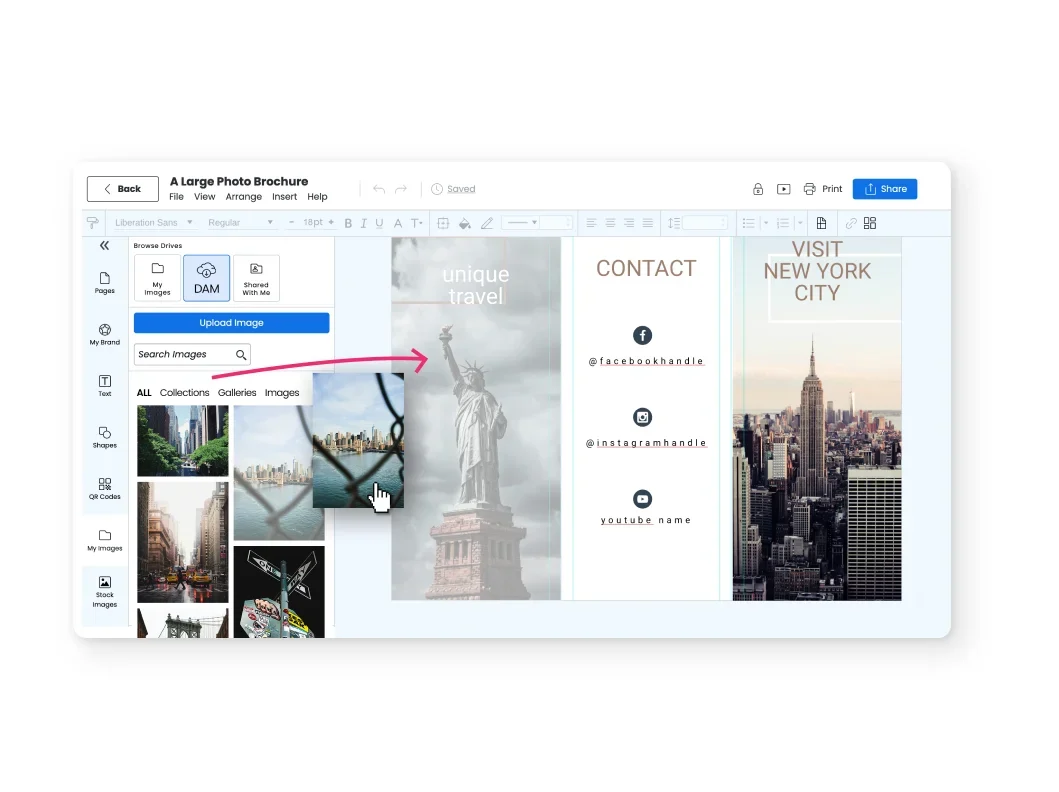
Templates live side-by-side with up-to-date assets. Approved templates are a click away from an auto-tagged asset library, so users can easily swap an image without leaving the editor. With shared permissions, analytics, and version control in one backend, every user stays on-brand, and every content change stays trackable.
Enterprise Use Cases: Brand Enablement and DAM in Action
While brand enablement + DAM is a winning combo for any business, it’s particularly powerful for enterprise and distributed teams.
How growing teams and enterprises activate brand at scale with Marq
Global and growing organizations use Marq’s brand enablement and DAM platform to streamline content management and creation, without sacrificing brand integrity.
Higher Education: Universities use Marq brand enablement and DAM to centralize approved imagery, videos, and branded templates for every campus client, college, department, or program. Locked templates for social posts and recruitment materials keep school colors and seals intact, while smart fields autofill program data (e.g., the dean’s signature on their donor thank you cards).
Healthcare: From multilingual clinic flyers to HIPAA-compliant patient forms, health systems use brand-locked templates to personalize content with only approved, local imagery. Designers are free to focus on community engagement campaigns instead of one-off, manual changes to patient fliers and provider directories.
Financial Services: Banks, lenders, and insurers can build personalized quotes, branch signage, and co-branded collateral in minutes. Marq Smart Fields pull live rates dynamically into content, templates meet FINRA standards, and version control tracks every change.
Real-world example of DAM+Brand Enablement: PT Solutions
To support their growing number of clinics, PT Solutions leaned into a solution blending accessibility, automation, and control. Using MediaValet (for DAM) and Marq (for Brand Enablement and Templating), the company built a system that empowered regional teams and non-technical users to create polished, localized content without overloading its short-staffed creative team.
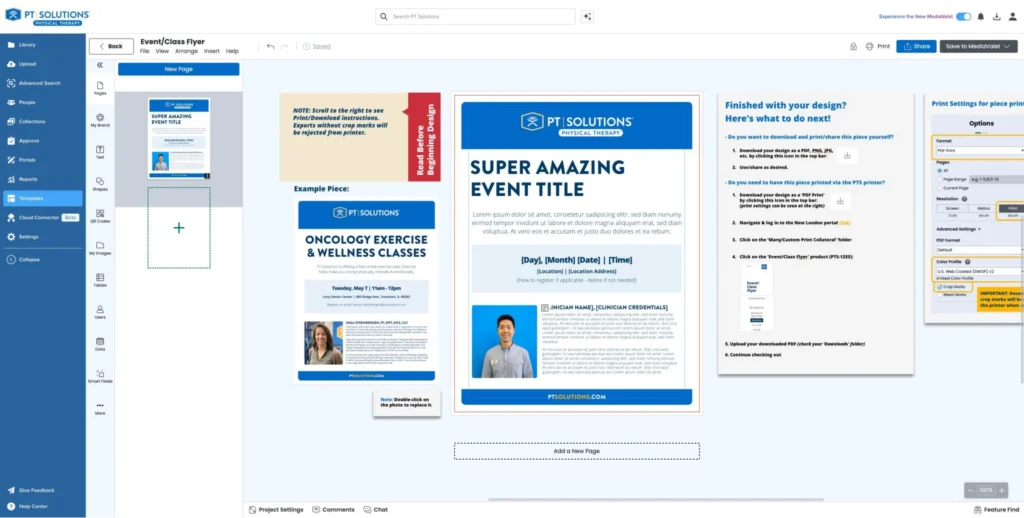
Here are some of their results:
- Same-Day Collateral Creation: Sales reps no longer wait weeks for creative support. Now they build customized flyers and bio cards in the same hour they need them, on-demand templates and access to relevant assets. Regional teams can move faster and more independently.
- Fewer Creative Bottlenecks: With templating and self-service portals in place, the volume of one-off design requests to the creative team dropped significantly. The marketing team is free to shift focus from daily production tasks to higher-impact strategic initiatives, like campaign planning and brand development.
- Consistent Branding Across 500+ Clinics: By locking down brand elements in Marq templates and centralizing all approved assets in MediaValet, PT Solutions has significantly reduced off-brand collateral. Whether it’s a clinic flyer, a co-branded sign, or an event promo, materials now meet consistent standards company-wide.
Now that we have a centralized, easy-to-use source of truth, we can guide people to the right assets and protect our brand—even as we keep growing.
– Malia Hostetler, Senior Manager of Creative Solutions at PT Solutions
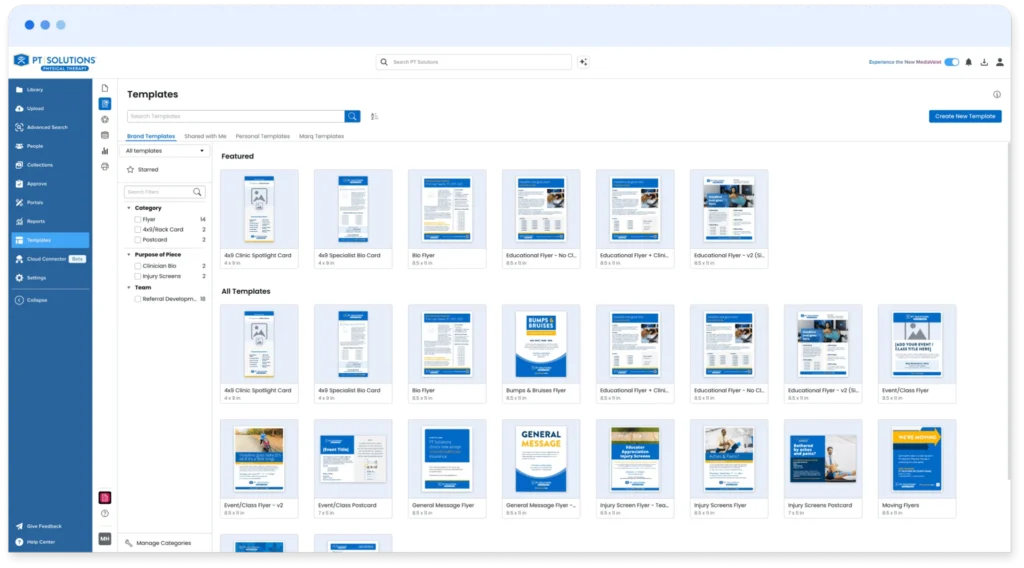
Measuring the Impact of Brand Enablement and DAM Integration
With built-in analytics, Marq and MediaValet let you track what’s working and optimize what’s not.
Marq Analytics: Aligning creative execution with business goals
Once your templates and assets are in place, Marq’s built-in analytics dashboards reveal which templates drive the most adoption, where bottlenecks occur, and which channels are being activated. You can connect content usage to business outcomes like increased campaign speed or improved regional sales.
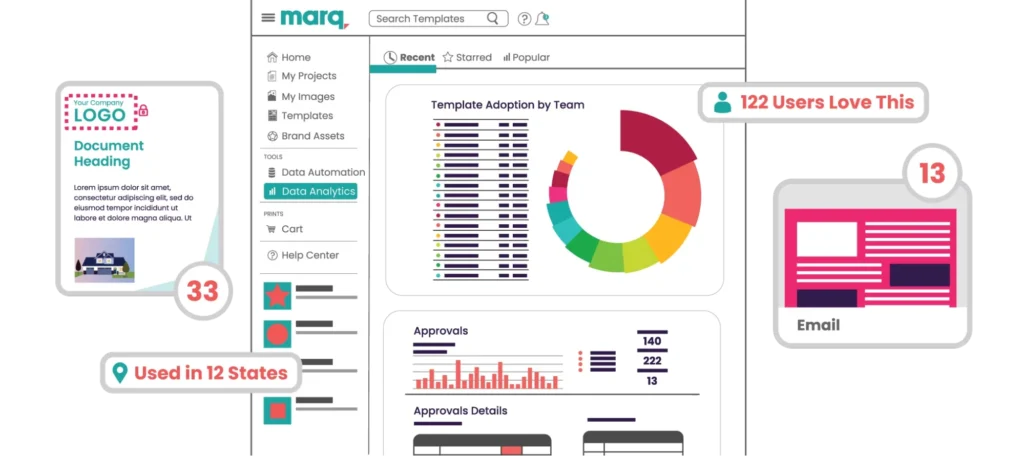
Suddenly you can tie a refreshed brochure to a spike in regional sales—or spot a dusty asset before it hurts the brand. As one customer put it, “Marq analytics helps us work smarter, not harder.”
Key metrics to watch: adoption, usage, and brand consistency scores
- Adoption Rate: % of active users vs. licenses
- Template Usage: Top- and bottom-performing assets
- Brand Consistency: Frequency of locked brand elements staying intact
- Workflow Time Saved: Compare time-to-publish before and after rollout of self-service system
Tracking these metrics monthly gives you hard data on what’s working and where to optimize next.
Future Trends in DAM and Brand Enablement
AI is transforming how creative teams operate, shifting marketing workflows from reactive to predictive. Here’s what to look for next:
Automation and AI-assisted asset workflows
- Live Smart Fields. Tie your CRM to a template once and watch names, offers, or product specs refresh automatically every time the asset is generated —no manual swaps, no busted personalization.
- Auto-tagging & visual search. AI scans every new upload for people, logos, and compliance cues, then applies precise tags so content surfaces itself in seconds.
- Predictive edits on tap. Need a square crop for Instagram or a Spanish headline? The system suggests (or just makes) the change and flags it for a quick thumbs-up.
Real-time brand performance monitoring
- Live dashboards that matter to revenue. See which assets actually move pipeline, bump click-throughs, or drive foot traffic, all without digging through six different reports.
- Instant alerts and ‘brand brain’ partner. Slack pings call out off-brand slides or expiring assets before they ship, while predictive scoring suggests when to refresh stale creative.
We’ve all seen the latest flood of “AI-powered” headlines. But when it comes to brand enablement and DAM, AI should work quietly behind the scenes, helping you keep pace with content demands.
What’s Next: Turning Brand Enablement Into a Competitive Advantage
Modern marketing teams can’t afford to choose between speed and brand control. With the right system, they don’t have to. Brand enablement, powered by integrated DAM and templating, turns your brand from a bottleneck into a growth engine.
If you’re ready to scale brand impact without sacrificing consistency, it’s time to build the system that makes it possible.
Ready to See Brand Enablement and DAM in Action?
Learn how Marq helps enterprise teams create, manage, and scale branded content — without bottlenecks or brand risk.


